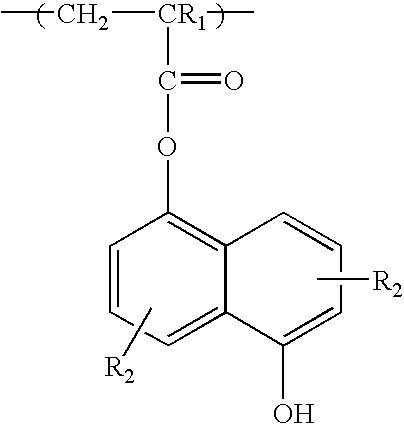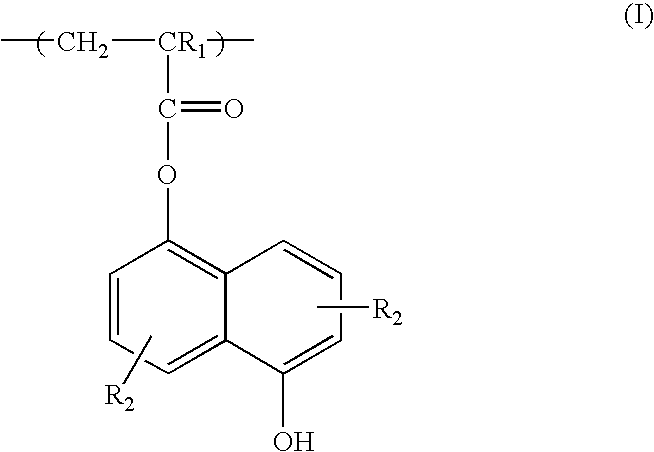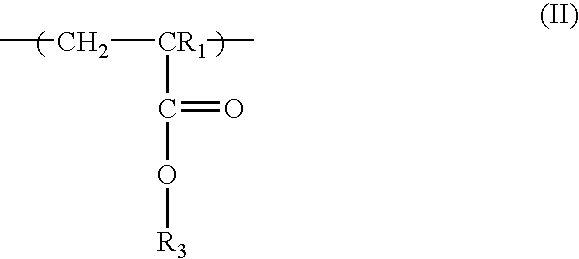Positive resist containing naphthol functionality
a technology of functionalities and positive resists, applied in the field of microelectronics industry, can solve the problems of limited ability to obtain finer resolution and limited ability to produce smaller devices, and achieve the effects of improving etch resistance for pattern transfer, high resolution lithographic performance, and reducing swelling
- Summary
- Abstract
- Description
- Claims
- Application Information
AI Technical Summary
Benefits of technology
Problems solved by technology
Method used
Image
Examples
synthesis example
[0053] 5-hydroxy-1-naphthalenyl methacrylate (a.k.a. hydroxynaphthalene methacrylate or NAMA) monomer (3.04 g, 0.0132 mole), 2-methyl-2-adamantyl methacrylate (a.k.a. methyl adamanyl methacrylate or MAdMA) monomer (14.10 g, 0.0600 mole), 5-methyacryloyloxy-2,6-norbornane carbolactone (a.k.a. norbornane lactone methacrylate or NLM) monomer (13.32 g, 0.0600 mole), azobisisobutyronitrile (AIBN) (1.52 g, 7% of the total mole of all monomers), n-dodecanethiol (n-DDT) (0.53 g, 2% of the total mole of all monomers) and 92 g of MEK methyl ethyl ketone were added to a 250 ml 3-neck round bottom flask equipped with condenser, thermometer, nitrogen inlet and magnetic stirrer bar to form a reaction mixture having 25 wt. % of the monomers. The reaction mixture was stirred at room temperature and bubbled with N2 flow for 45 minutes after which is was heated to 67-70° C. and stirred for 13 hours with a blanket N2 flow. After reaction, the solution was then cooled to room temperature, diluted with ...
resist example 1
[0055] A terpolymer of MAdMA, NLM, and NAMA with composition of 45 / 40 / 15 mole ratio was dissolved in PGMEA with 4.5 wt % BNBS-PFOS (based on the polymer weight) and 0.17 wt % 1-t-butyloxycarbonyl 2-phenylbenzimidazole (based on the polymer weight) to make a solution of 11% solid content. The resulting solution was filtered through a 0.2 μm filter. The resist was spin coated on an 8-inch silicon wafer which had a 900 Å thick coating of antireflective coating (“AR40” from Rohm & Haas Electronic Materials). The resist was baked at 130° C. for 60 seconds and exposed to ArF (193 nm wavelength) imaging radiation on an ASML scanner (0.75 NA). The exposed wafer was then baked at 130° C. for 90 seconds. The wafer was then developed using a single-spray puddle develop process for 60 seconds with 0.263 N TMAH developer (Moses Lake's AD-10). Under these process conditions, 192 nm lines on a 315 nm pitch were resolved.
resist example 2
[0056] A terpolymer of (MAdMA / NLM / NAMA) with composition of 49 / 44 / 7 mole ratio was dissolved in PGMEA with 4.5 wt % BNBS-PFOS (based on the polymer weight) and 0.17 wt % 1-t-butyloxycarbonyl 2-phenylbenzimidazole (based on the polymer weight) to make a solution of 11% solid content. The resulting solution was filtered through a 0.2 μm filter. The resist was spin coated on a 8-inch silicon wafer which had a 900 Å thick coating of antireflective coating (“AR40” from Rohm & Haas Electronic Materials). The resist was baked at 130° C. for 60 seconds and exposed to ArF (193 nm wavelength) imaging radiation on an ASML scanner (0.75 NA). The exposed wafer was then baked at 130° C. for 90 seconds. The wafer was then developed using a single-spray puddle develop process for 60 seconds with 0.263 N TMAH developer (Moses Lake's AD-10). Under these process conditions, 85 nm lines on a 245 nm pitch were resolved.
PUM
| Property | Measurement | Unit |
|---|---|---|
| Tg | aaaaa | aaaaa |
| wt. % | aaaaa | aaaaa |
| temperature | aaaaa | aaaaa |
Abstract
Description
Claims
Application Information
 Login to View More
Login to View More - R&D
- Intellectual Property
- Life Sciences
- Materials
- Tech Scout
- Unparalleled Data Quality
- Higher Quality Content
- 60% Fewer Hallucinations
Browse by: Latest US Patents, China's latest patents, Technical Efficacy Thesaurus, Application Domain, Technology Topic, Popular Technical Reports.
© 2025 PatSnap. All rights reserved.Legal|Privacy policy|Modern Slavery Act Transparency Statement|Sitemap|About US| Contact US: help@patsnap.com



